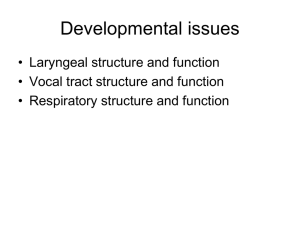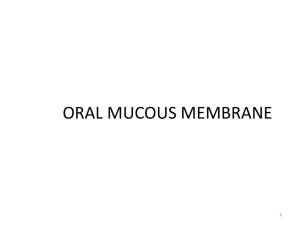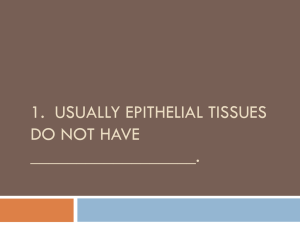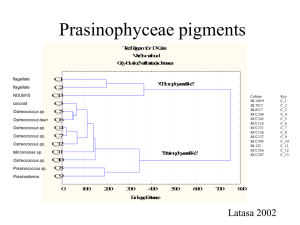lecture 11
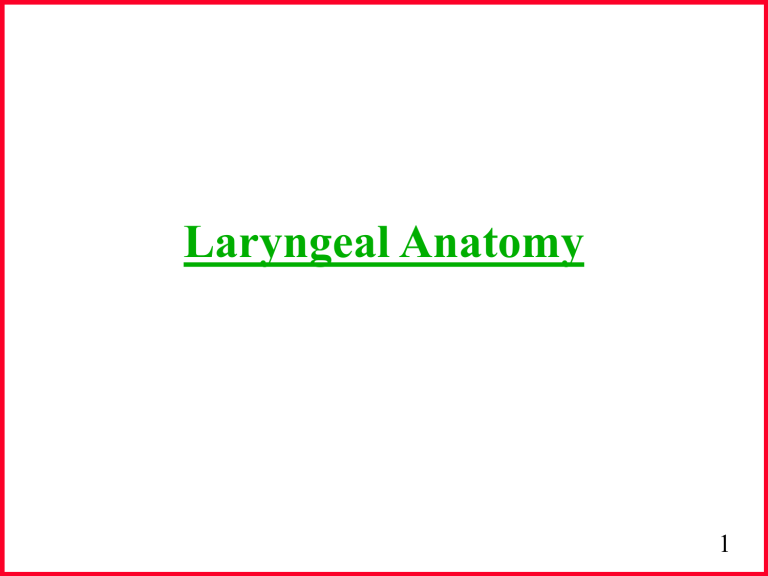
Laryngeal Anatomy
1
Development of the voice
• Birth:
-larynx has higher anatomical position
-6th level of the cervical region
-pitch of neonate= 700 Hz
• 2 years:
-soft cartilage's & lax ligaments
(susceptible to collapse)
-ossification of hyoid cartilage's
2
• 5 years:
-larynx assumes position C7
-pitch decreases
• 20 years:
-hardening of the cricoid
• 30 years:
-hardening of the arytenoid
• 65 years:
-ossification of all cartilage's except the cuneiform & corniculate
3
Four voicing signals in the neonate
• Birth Signal-
-short duration (1 sec.)- vowel pattern
• Pain Signal-
-long in duration, high-pitched
-strained harsh quality
• Hunger signal-
-rising & falling of pitch; glottal signal
• Pleasure Signal-
-more nasal, pitch variability, glottal quality
4
Differences: Female & Male Voices
• Prepubescent-
-minimal, similar pitch
• Puberty-
-male v.f.’s enlarge 8-10mm & females 4mm
-thyroid angle is 90 ° in males and 120 °in females.
-v.f.’s enlarge in both female & male
-epiglottis flattens
-v.f. mucosa becomes less transparent
-tonsils & adenoids atrophy 5
Geriatric vocal folds
• deterioration in pitch, loudness range,& endurance
• v.f.’s appear thin & bowed
• “aging larynx”= Presbylaryngeus
• breakdown of collagenous & elastic fibers
• intermediate layers of v.f.’s are looser & thinner
• bowed appearance during glottal closure
• thickening of superficial layer of lamina propria.
6
Vocal Fold Microstructure
• Membranous portion of v.f.’s is intricate & layered,
• There are 5 histologically discrete layers,
• Layers vary in composition and mechanical properties,
7
Histologic Layers
• 5 histologic layers from most superficial to most deep are:
• Epithelium
• Lamina propria (3 layers)
-superficial layer
-intermediate layer
-deep layer
• Vocalis muscle
8
Vocal Ligament
Epithelium
Lamina Propria superficial layer intermediate layer deep layer
Vocalis Muscle
9
Frontal section through membranous portion epithelium lamina propria superficial intermediate deep vocalis muscle conus elasticus epithelium lamina propria superficial intermediate deep vocalis muscle conus elasticus
10
Epithelium
• thin mucosal covering of squamous cells
• wraps around internal contents of v.f.’s
• no mass, totally compliant
• needs thin layer of mucous lubrication to oscillate best.
11
Lamina Propria
•
Consists of three layers :
1) Superficial layer-
-composed of loose fibrous matrix
(known as Reinke’s space)
-composition described as soft gelatin
2) Intermediate layer-
-composed of elastic fibers and has slightly more mass
12
3) Deep layer-
-denser still, composed of collagenous fibers
• Tissues of 3rd & 4th layers together are known as the vocal ligament
• The vocal ligament develops throughout childhood until the larynx reaches full maturity (puberty)
13
Vocalis Muscle
• Fifth layer
• Main body of the vocal fold
• Provides stability and mass
14
5 layers
• As layers change from superficial to deep, mass gradually changes & compliance for vibration
• Epithelial; most elastic
• Subsequent layers form a complex transition
• Finally, stiff deep muscle tissue
15
The Body-Cover Model
• Theory developed by Hirano (1974)
• Model attempts to explain the extreme variability in voice production
• Model explained:
-Cover :(epithelium & superficial layer of the lamina propria)
-Transition:(intermediate and deep layer of the lamina propria)
-Body : (vocalis muscle)
16
•
Cover:
1) epithelium
2) lamina propria
-superficial
•
Transition
1) intermediate
2) deep
•
Body vocalis muscle
17
More on Body-Cover
• Characteristics of v.f. vibration are dependent on:
-length
-elastic properties
-mass distribution
• Body contraction/ vocalis contraction= the cover becomes shortened and thicker giving more mass to the length unit
• Cover is entirely passive; longitudinal state is specified by its length & lateral displacement depends on the thickness of its body.
18
Some clinical observations
• When CT and vocalis activity are weak: movement of body & cover are identical,
• When vocalis activity is strong and the CT is weak: movement is greater for the cover rather than body,
• When CT is active and vocalis is relaxed: both the body & cover are equally stiffened, movement is minimal (e.g.. Falsetto).
19
Histology
• Cartilage's are made up of two different types of tissue
-Thyroid & Cricoid= Hyaline cartilage
-Epiglottis, cuneiform & corniculate= elastic cartilage
• Hyaline: thin, dense collagenous fiber
(protein based)
• Elastic: elastic fibers
20
Histological differences between structures
• v.f. layered structure varies along its length
• How does the membranous portion of the v.f. connect to the cartilaginous framework?
-at anterior end of v.f.’s :
*macula flava (a mass of elastic fibers, attached to ant. commissure)
-at posterior end of v.f.’s:
*post. macula flava (attached directly to arytenoid cartilage
21
Function of Macula Flava
• Hypothesized to protect the membranous portion of the vocal folds during vibration from mechanical damage.
22
Structure in Newborns
• Epithelium is similar to adults
• Major difference: lamina propria is thick relative to its v.f. length
(adult’s thinner)
• No vocal ligament
23
Trends in Vocal Fold Growth
• immature macula flava in newborns (more susceptible to damage),
• immature vocal ligament appears at 4 years (still very thin & does not contact vocalis muscle),
• 3 layers of lamina propria don’t exist until the ages 6-12,
• thickness of cover and lamina propria increase with age,
• intermediate lamina propria gets thinner with age,
• deep layer of lamina propria gets thicker.
24
Summary regarding thickness
1) Cover thickest at midportion
2) Lamina propria thinnest at midportion lamina propria thickest at the two ends, ant.
& post. macula flava
4) Vocalis muscle thicker than mucosa- thinner in the ant. end & thicker at post. end
5) Vocalis muscle thicker than mucosa- thinner in the anterior end, thicker at the posterior end.
25
Changes with age
1) Cover gets thicker with age- not in epithelium but superficial layer of lamina propria,
2) Superficial layer of lamina propria becomes swollen with age,
3) Elastic fibers become looser with aging, especially in males 40 years and older
4) Great individual differences in changes of v.f. structure as a function of aging.
26
Reading
• Seikel: Pgs.164-204 (If you already read chapter from last lecture, disregard)
27

